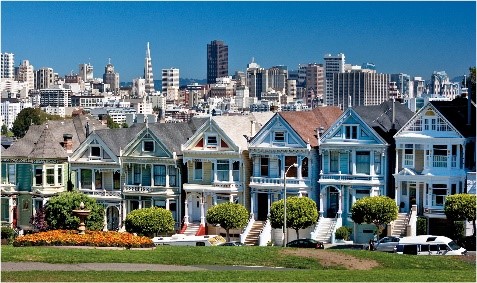Sandra Hernandez, President of Azul Works, Inc. is based out of San Francisco, CA. Additional remarks in this article also come from Balmore Hernandez, who is retired from Azul Works. Together, they discuss if there truly is an end to single family zoning in San Francisco and how it has affected the city.
San Francisco is arguably the most expensive city in the United States with an average home price of over $1.5 million. City planners have long been aware of the rising costs and are now working to lower prices and develop more affordable housing options. In a culmination of events, the San Francisco Board of Supervisors overruled long-standing single-family zoning laws that have helped drive up prices according to Sandra Hernandez of Azul Works.
Although San Francisco is famous for its rows of single-family Queen Anne homes, the city will soon see a shift toward quadruplex and six-unit housing blocks. Today, Sandra Hernandez of Azul Works looks at why the city voted to do away with single-family zoning laws and how it will transform America’s most expensive real estate into a more accessible city zone.
What is Single-Family Zoning and How Has it Affected San Francisco?


In order to understand the recent decision to do away with single-family zoning, it’s important to know what it is and how it came to be. Sandra Hernandez of Azul Works explains that
single-family zoning is a land-use designation that only permits detached homes on separate lots. This housing designation was put into place to preserve the “character” of neighborhoods and prevent high-density development.
Although it may seem like a good idea to keep things “as is,” this type of zoning has been linked to rising housing costs and income inequality. In San Francisco, the effects of single-family zoning have been especially pronounced. The city’s population has grown by nearly 100,000 people in the last ten years, but the number of housing units has only increased by 35,000 explains Sandra Hernandez of Azul Works.
The limited supply of housing has driven up prices to the point where the average rent for a one-bedroom apartment is over $3,000. In order to address the city’s housing crisis, the Board of Supervisors voted to do away with single-family zoning in all but a few neighborhoods.
San Francisco’s Solution to Single-Family Zoning
The Golden City has long been known for its steep hills, foggy bay, and rows of nostalgic Queen Anne homes. Unfortunately, though, that quaint aesthetic is no longer sustainable in a modern city says Balmore Hernandez, formerly of Azul Works. To address the downsides of single-family zoning, San Francisco has voted to allow quadruplex housing in every area of the city, as well as six-unit homes on every street corner.

This will help to accommodate San Francisco’s growing population and hopefully drop the city’s inaccessibly high housing prices. Of course, there has been some pushback against the Board of Supervisors’ decision, mainly arguing that the move will make it harder for project managers to secure fast-tracked permit approval says Balmore Hernandez, previously with Azul Works.
The Board was quick to point out that its decision will likely produce little effect at first but it’s a big move in the right direction. In time, the city’s decision to restructure itself will attract new residents and drive economic growth outside of San Francisco’s notorious tech-centered industry.
What Does the End of Single-Family Zoning Mean for San Francisco?
Final Thoughts on Single-Family Zoning in San Francisco The end of single-family zoning will have a huge impact on San Francisco’s real estate market says Balmore Hernandez, formerly of Azul Works. The most immediate change will be an increase in the construction of apartment buildings and other multi-unit dwellings. This will provide much-needed relief for the city’s housing crisis and make rent more affordable for families and individuals.

In the long run, the city’s decision to do away with single-family zoning will have a profound effect on its
social and economic fabric. The city’s wealthy residents have long used single-family zoning to maintain their grip on power. By opening up the city to more density, the playing field will be leveled, and more people will have access to the city’s resources says Balmore Hernandez, retired from Azul Works. The end of single-family zoning is a huge victory for housing advocates and a major step forward for the city of San Francisco. However, its wealthier residents are expected to push back against the decision in fear that their housing values could also drop. For now, though, it seems that only time can tell where the Golden City is headed.
For generations, San Franciscan urban planning has been defined by its focus on single-family homes explains Sandra Hernandez of Azul Works. Although this approach has created a stately and aesthetically unique metropolis, it’s undeniably made the city of the most expensive and inaccessible in the world. Understandably, city planners are now working to undo these effects.

Azul Works says that by repealing single-family zoning laws, the San Francisco Board of Supervisors will open the city to larger housing units and make the city more inclusive. This is only the first step though and it’s unclear how the city will change as a result.

 In order to understand the recent decision to do away with single-family zoning, it’s important to know what it is and how it came to be. Sandra Hernandez of Azul Works explains that single-family zoning is a land-use designation that only permits detached homes on separate lots. This housing designation was put into place to preserve the “character” of neighborhoods and prevent high-density development.
Although it may seem like a good idea to keep things “as is,” this type of zoning has been linked to rising housing costs and income inequality. In San Francisco, the effects of single-family zoning have been especially pronounced. The city’s population has grown by nearly 100,000 people in the last ten years, but the number of housing units has only increased by 35,000 explains Sandra Hernandez of Azul Works.
The limited supply of housing has driven up prices to the point where the average rent for a one-bedroom apartment is over $3,000. In order to address the city’s housing crisis, the Board of Supervisors voted to do away with single-family zoning in all but a few neighborhoods.
San Francisco’s Solution to Single-Family Zoning
The Golden City has long been known for its steep hills, foggy bay, and rows of nostalgic Queen Anne homes. Unfortunately, though, that quaint aesthetic is no longer sustainable in a modern city says Balmore Hernandez, formerly of Azul Works. To address the downsides of single-family zoning, San Francisco has voted to allow quadruplex housing in every area of the city, as well as six-unit homes on every street corner.
In order to understand the recent decision to do away with single-family zoning, it’s important to know what it is and how it came to be. Sandra Hernandez of Azul Works explains that single-family zoning is a land-use designation that only permits detached homes on separate lots. This housing designation was put into place to preserve the “character” of neighborhoods and prevent high-density development.
Although it may seem like a good idea to keep things “as is,” this type of zoning has been linked to rising housing costs and income inequality. In San Francisco, the effects of single-family zoning have been especially pronounced. The city’s population has grown by nearly 100,000 people in the last ten years, but the number of housing units has only increased by 35,000 explains Sandra Hernandez of Azul Works.
The limited supply of housing has driven up prices to the point where the average rent for a one-bedroom apartment is over $3,000. In order to address the city’s housing crisis, the Board of Supervisors voted to do away with single-family zoning in all but a few neighborhoods.
San Francisco’s Solution to Single-Family Zoning
The Golden City has long been known for its steep hills, foggy bay, and rows of nostalgic Queen Anne homes. Unfortunately, though, that quaint aesthetic is no longer sustainable in a modern city says Balmore Hernandez, formerly of Azul Works. To address the downsides of single-family zoning, San Francisco has voted to allow quadruplex housing in every area of the city, as well as six-unit homes on every street corner.
 This will help to accommodate San Francisco’s growing population and hopefully drop the city’s inaccessibly high housing prices. Of course, there has been some pushback against the Board of Supervisors’ decision, mainly arguing that the move will make it harder for project managers to secure fast-tracked permit approval says Balmore Hernandez, previously with Azul Works.
The Board was quick to point out that its decision will likely produce little effect at first but it’s a big move in the right direction. In time, the city’s decision to restructure itself will attract new residents and drive economic growth outside of San Francisco’s notorious tech-centered industry.
What Does the End of Single-Family Zoning Mean for San Francisco?
Final Thoughts on Single-Family Zoning in San Francisco The end of single-family zoning will have a huge impact on San Francisco’s real estate market says Balmore Hernandez, formerly of Azul Works. The most immediate change will be an increase in the construction of apartment buildings and other multi-unit dwellings. This will provide much-needed relief for the city’s housing crisis and make rent more affordable for families and individuals.
This will help to accommodate San Francisco’s growing population and hopefully drop the city’s inaccessibly high housing prices. Of course, there has been some pushback against the Board of Supervisors’ decision, mainly arguing that the move will make it harder for project managers to secure fast-tracked permit approval says Balmore Hernandez, previously with Azul Works.
The Board was quick to point out that its decision will likely produce little effect at first but it’s a big move in the right direction. In time, the city’s decision to restructure itself will attract new residents and drive economic growth outside of San Francisco’s notorious tech-centered industry.
What Does the End of Single-Family Zoning Mean for San Francisco?
Final Thoughts on Single-Family Zoning in San Francisco The end of single-family zoning will have a huge impact on San Francisco’s real estate market says Balmore Hernandez, formerly of Azul Works. The most immediate change will be an increase in the construction of apartment buildings and other multi-unit dwellings. This will provide much-needed relief for the city’s housing crisis and make rent more affordable for families and individuals.
 In the long run, the city’s decision to do away with single-family zoning will have a profound effect on its social and economic fabric. The city’s wealthy residents have long used single-family zoning to maintain their grip on power. By opening up the city to more density, the playing field will be leveled, and more people will have access to the city’s resources says Balmore Hernandez, retired from Azul Works. The end of single-family zoning is a huge victory for housing advocates and a major step forward for the city of San Francisco. However, its wealthier residents are expected to push back against the decision in fear that their housing values could also drop. For now, though, it seems that only time can tell where the Golden City is headed.
For generations, San Franciscan urban planning has been defined by its focus on single-family homes explains Sandra Hernandez of Azul Works. Although this approach has created a stately and aesthetically unique metropolis, it’s undeniably made the city of the most expensive and inaccessible in the world. Understandably, city planners are now working to undo these effects.
In the long run, the city’s decision to do away with single-family zoning will have a profound effect on its social and economic fabric. The city’s wealthy residents have long used single-family zoning to maintain their grip on power. By opening up the city to more density, the playing field will be leveled, and more people will have access to the city’s resources says Balmore Hernandez, retired from Azul Works. The end of single-family zoning is a huge victory for housing advocates and a major step forward for the city of San Francisco. However, its wealthier residents are expected to push back against the decision in fear that their housing values could also drop. For now, though, it seems that only time can tell where the Golden City is headed.
For generations, San Franciscan urban planning has been defined by its focus on single-family homes explains Sandra Hernandez of Azul Works. Although this approach has created a stately and aesthetically unique metropolis, it’s undeniably made the city of the most expensive and inaccessible in the world. Understandably, city planners are now working to undo these effects.
 Azul Works says that by repealing single-family zoning laws, the San Francisco Board of Supervisors will open the city to larger housing units and make the city more inclusive. This is only the first step though and it’s unclear how the city will change as a result.
Azul Works says that by repealing single-family zoning laws, the San Francisco Board of Supervisors will open the city to larger housing units and make the city more inclusive. This is only the first step though and it’s unclear how the city will change as a result.